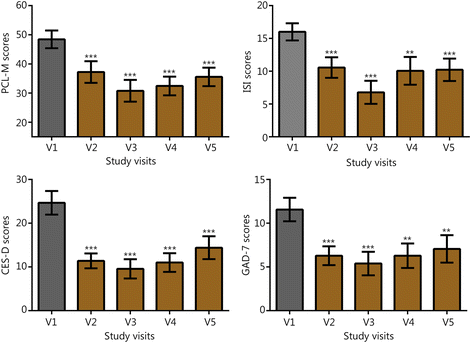Numerous symptom clusters are known to be correlated with posttraumatic stress disorder (PTSD). Often, behavioral disturbances, such as negative mood, heightened arousal, avoidance, and flashbacks, are considered the main symptom clusters; however, recent studies have also indicated that Service members with PTSD have an increased risk for developing metabolic and cardiovascular diseases. As such, disruption of autonomic regulation of the cardiovascular system, a risk factor for cardiovascular disease, has been shown to occur in Service members and veterans diagnosed with PTSD. One explanation for this dysregulation proposes that traumatic stress can produce asymmetric activity in brain regions responsible for autonomic management. Researchers at Wake Forest School of Medicine theorized that calibrating neural oscillations may alleviate behavioral and physical PTSD-related symptoms.
To test this theory, 18 Service members or recent veterans with symptoms of military-related traumatic stress, 15 of whom reported concussion or traumatic brain injury history, were enrolled in a study examining the effects of High-resolution, relational, resonance-based, electroencephalic mirroring (HIRREM®, Brain State Technologies, Scottsdale, AZ). HIRREM is a noninvasive, closed-loop, allostatic, acoustic stimulation technology designed to facilitate relaxation and auto-calibration of neural oscillations. Using a mathematical algorithm, computer software converts brainwaves to audible tones in real time, and mirrors those back via earbuds. Participants in the study received a median of 19.5 HIRREM sessions over a 12-day intervention period and were assessed for up to 6 months across measures of symptom severity, autonomic cardiovascular regulation, epigenetics, and stress biomarkers.


Researchers observed statistically significant improvements in self-reported symptom scores for PTSD, insomnia, depressive mood, and anxiety across all four post-baseline follow-up visits. In addition, the sub-cohort of participants with TBI or concussion history reported lasting reductions in concussion-related symptoms. HIRREM was also shown to modulate autonomic cardiovascular regulation in the short-term, as measured by changes in heart-rate variability and baroreflex sensitivity. Both measures significantly increased immediately after receiving the intervention. Although additional studies are warranted to test the durability of modulating such objective physiological outcomes, this work demonstrated improvements in behavioral symptomology using a well-tolerated, non-invasive intervention.
More information is available at www.wakehealth.edu/HIRREM.Tegeler, C. L., Gerdes, L., Shaltout, H. A., Cook, J. F., Simpson, S. L., Lee, S. W., & Tegeler, C. H. (2017). Successful use of closed-loop allostatic neurotechnology for post-traumatic stress symptoms in military personnel: self-reported and autonomic improvements. Military Medical Research, 4(1), 38.
Your 15 minute session will timeout in approximately 10 minutes.
If you're in the middle of entering information, please close this warning and save your progress (if possible) or finish up your task.
If your session fully times out, you will lose any un-saved work.
Your current Blast Injury Research Program session has expired.
Your next click will take you away from the private area, and you will lose any work you have in-progress.
Please enter your email address, and try again.